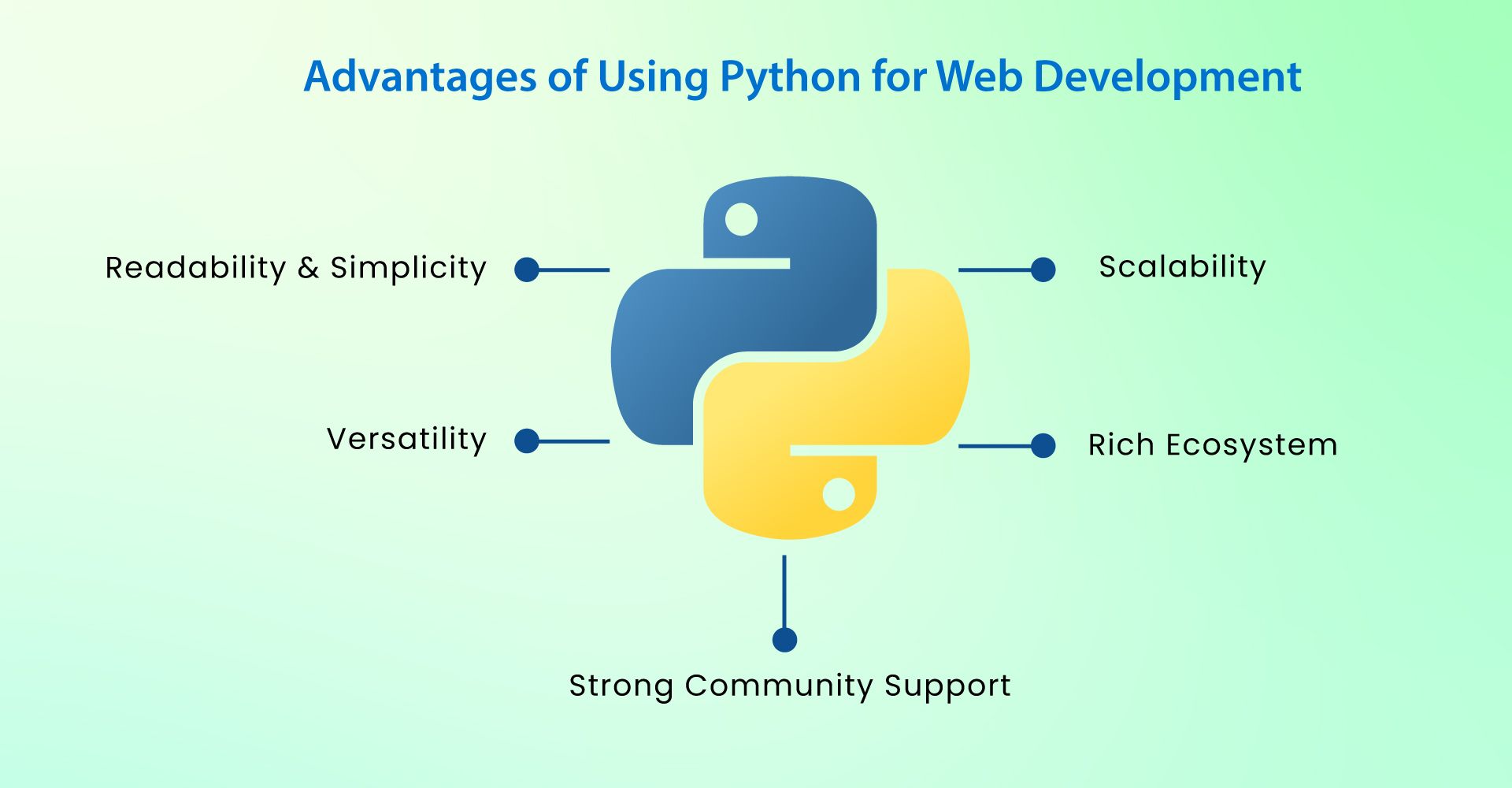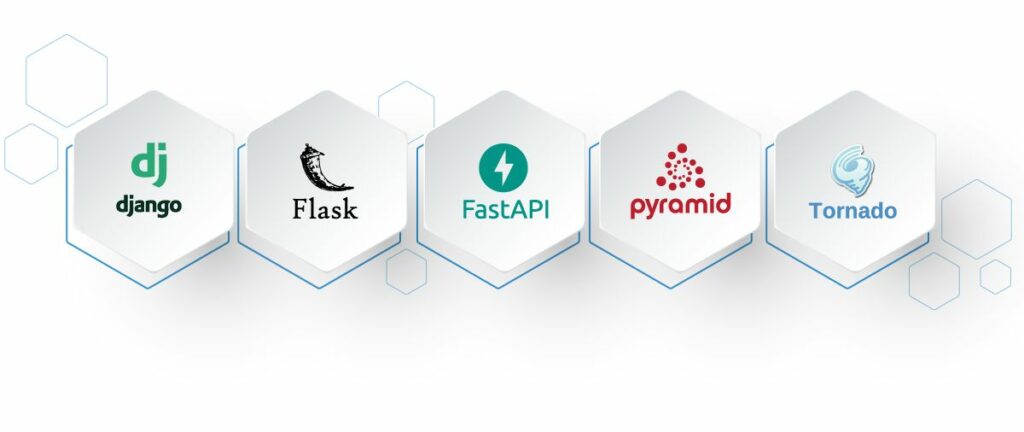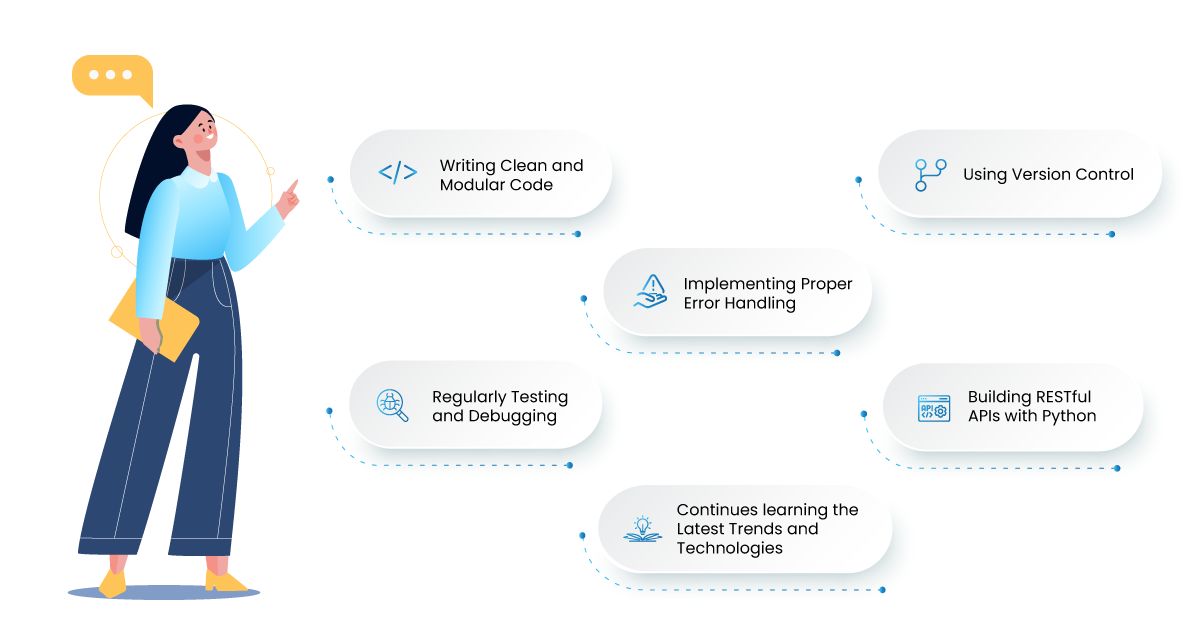Everything you need to know about Web development in Python
Python is a popular programming language known for its simplicity, readability, and versatility. It executes code line by line as an interpreted language rather than being compiled, making it more accessible for writing and testing code. Consequently, the turnaround time is reduced, enabling us to quickly obtain the desired application.
Transitioning to the next point, Python finds applications in various domains such as web development, data analysis, artificial intelligence, automation, and web scraping. Additionally, it benefits from extensive community support that organizes excellent virtual events. One notable event is Pycon, which takes place worldwide.
Django, Flask, FastAPI, Cherrypy, etc., are popular Python frameworks that developers widely use for Python web development. Any framework can utilize various libraries to expedite development.

Python’s popularity in web development
“Building a scalable application using Python is impossible” is a myth. Many popular applications across different domains are built using Python. Let’s see how Python fares in building different kinds of applications.
Many companies choose to develop websites using Python. Transitioning to a more active voice, Python is the preferred language for web development by many companies. The widespread application Instagram, built using Python, supports approximately 500 million users daily, highlighting the need for Python’s scalability. Transitioning to another example in the entertainment field, Spotify, a platform built using Python, is worth mentioning. Moving on, Python finds applications in creating sought-after community platforms like Reddit and Quora. Notably, the Django framework was employed to build Quora.
In the cloud storage domain, Dropbox, a prominent player in the industry, harnesses the power of Python. Moreover, numerous applications initially developed with different technologies were later migrated to Python. An exemplary case is YouTube, which serves as a testament to the capabilities of Python.
Advantages of Using Python for Web Development
Now that we know what Python is, let’s look at the benefits of using Python in web development. Let us understand why developers prefer Python in web programming.

Readability and simplicity
For someone wanting to enter the programming world, Python is a go-to language. The syntax is straightforward. It requires fewer words and fewer lines of code to build applications.
Since it is simple to write, it also makes it easy to read. This helps Python developers easily maintain the code. This also helps in debugging any issue quickly compared to other languages.
Scalability
Programmers can build monolithic as well as serverless applications using Python. So they can select the style based on their needs for application scalability. Python also supports asynchronous programming to handle concurrent requests that may be required in any application.
Rich ecosystem
Python developers also have a vast source of libraries to select for web development with Python. Python Package Index (PyPI) is a repository of libraries of Python software.
PyPI contains more than 450,000 projects, and the number is increasing daily. Apart from libraries, various frameworks are available for Python web app development. Django, Flask, FastAPI, etc., are popular frameworks for Python web programming.
Versatility
Python supports object-oriented, functional, and procedural programming while being cross-platform compatible. This means it can be used in almost any operating system. Additionally, Python can run on small systems such as raspberry pi, making it one of the most versatile programming languages. Due to its versatility, Python finds extensive application in rapid prototyping and experimentation.
Strong community support
Strong community support is one of the main reasons for pythons’ popularity. Additionally, the community has many members from all over the world. Consequently, if one is stuck developing any feature, one can quickly obtain quick support from the community. Furthermore, there might be a possibility that someone already has a solution to the problem.
Python Web Frameworks

So far, we learned about Python, What web programming is in Python, and its advantages. Let’s get to the part on How to use Python for web development. We know there are multiple frameworks in Python. We will take a look at a few of those next.
Django
As a Fullstack framework, Django is the preferred choice for most organizations and developers due to its comprehensive feature set. Firstly, it includes most things by default, making it highly convenient. Moreover, Django follows the Model View Controller architecture pattern, further enhancing its structural integrity. Additionally, the framework provides an inbuilt admin module, which allows even non-technical individuals to easily add or delete data from the app.
Django developers use the ORM layer to simplify database interactions rather than writing raw SQL queries.
Flask
Flask is a microframework used for small applications. Unlike Django, Flask does not contain a database abstraction layer. It is a very minimal framework. Developers can use any external package conveniently rather than relying on inbuilt functionalities.
For someone who wants to start Python web development, Flask can be a perfect starting point for web development with Python.
It is also a popular framework in the data science community for deploying machine learning models in Production.
FastAPI
FastAPI has been gaining popularity recently due to its speed and performance, which is on par with nodejs and go language. It helped the Python language to overcome the myth that Python is slow in performance compared to other languages.
It uses the asynchronous nature of Python’s asyncio library to handle many concurrent connections efficiently. Due to its performance, this framework is also gaining popularity in the Data Science community. Many developers are shifting to use FastAPI to build APIs quickly and have other frontend languages of choice.
Pyramid
Pyramid fills the gap between big frameworks like Django and lightweight frameworks like Flask. The modular architecture of Pyramid allows Python programmers to start small and finish big using this framework. Pyramid is easily extensible, which means you can use customized as per your project need.
Tornado
Say you want to build a chat application using Python; now, this needs asynchronous programming. Here Tornado comes to the rescue as it is an asynchronous networking library. It uses a non-blocking I/O network suitable for applications like chat and tickers. Web applications with extensive concurrent request handling can also be built using Tornado.
Essential Python Libraries for Web Development
Besides frameworks, Python has many libraries designed to do specific tasks. Let us take a look at some of the popular libraries.

Requests
API (Application programming interface) is the core of any software. It helps to communicate between two different software. Say you want to use external data or services already built into your application. Then the best way to communicate is to use API.
To make use of APIs in your Python program requests library is used. Take a simple example, considering you want to show weather updates in the application. One can make an API call to an external weather API, like open weather to the current weather.
One can use requests to handle cookies, authentication, and even file uploads.
Beautiful Soup
You use this library when you want to scrape/extract information from any website. Beautiful Soup helps you navigate the document tree, search for specific elements, and extract the data. It supports HTML, XML, and HTML5lib parsers.
Scrapy
This is another library or, instead, a framework for web scraping. Say you want to scrape all the products of an e-commerce website, then scrappy is the way to proceed. It hosts a lot of inbuilt features that are required for web scraping. Scrappy supports IP rotation, link following. It can scrape multiple pages simultaneously once you give the pattern on the weblinks of the source.
SQLAlchemy
Where there are programs, there is a database. SQLAlchemy is a database connection library. It is an Object-Relational Mapping (ORM) tool for Python. It supports database connections to PostgreSQL, MySQL, SQLite, and Oracle.
NumPy
Numpy is used where there are mathematical calculations. It supports operations on N-dimensional arrays, making it popular among the scientific community. Many libraries used in the Data Science community use Numpy APIs. Pandas, Scikit-learn, Scikit-Image, etc., are some NumPy libraries.
Python Web Development Tools
Python offers a rich ecosystem of web development tools to help you build robust and scalable web applications. Here are some popular Python web development tools:
Integrated Development Environments (IDEs):
The IDE is a comprehensive tool that speeds up the development process by compiling an editor, compiler, and interpreter. Many IDEs can facilitate Python web application development. Python’s default IDLE serves as the fundamental option.
JetBrains created Pycharm, which was a popular IDE among Python developers. It also has limited support for using extensions.
VScode offers extensive extension support and integrates with GitHub Copilot to accelerate development. The scientific community extensively utilizes Jupyter Notebook for building their machine learning models.
Code editors
Code editors are simple, like text editing, but a little mature, where you can correct the intended more effectively. Atom and Sublime Text are popular editors for all OS types, i.e., Linux, Windows, and MacOS.
If we have to use a shell, the VI editor is famous on Linux distros and MacOS. Notepad++ is available for Windows OS.
Debugging and testing tools
Many IDEs default to supporting debugging in the application. Why is debugging important? When the application is ready and built, but certain functions are not working as expected, debuggers come to your aid.
Debuggers help in such scenarios. Testing implies that your code has been tested by developers who write unit test cases using PyTest.
Coverage is another tool that identifies the code coverage of the unit tests written by developers. If the coverage is low, it indicates the absence of sufficient test cases and a lack of code sanity checks.
Version control systems
For example, a big project is ongoing; 10 different developers are working on the same project. How does one track the changes to a project? This is where Version control systems come into play. Github, Bitbucket, and GitLab are the most widely used version control based on Git.
We also have SVN, which is not used for version control. In version control, we can add tags and releases to identify the stale versions of the software. We can also roll back to the previous state, where the software worked smoothly.
Python Web Development Best Practices
For any development process, we have to follow best industry practices. Let’s see what are the best practices for Python web application development.
Following these practices ensures the smooth and timely release of the application. It also helps in tracking and debugging effectively. In this section, we will see the best practices to be followed.

Writing clean and modular code
Modularity avoids code repetition and reusability, so we must follow a modular approach. This reduces the complexity of the application. Writing clean code is also essential.
We need to add comments as much as possible. Any new person knows what the code is about or what logic the developer has tried in the code. The programmer needs to ensure that one block of code is not significant. If it is turning big, break it down. Ensure good variable names are used. Follow coding standards like PEP8 in the application.
Implementing proper error handling
The code should handle errors properly and gracefully handle unexpected things. Use the Try Except block to avoid errors and provide appropriate error messages. Return the correct error codes in the application and establish a suitable logging mechanism for the errors.
Using version control
We saw different version control solutions. Developers should push their code daily. When working in an Agile environment, version control is of great help.
Build a specific feature in a project, raise the PR, and then test the code. If there are problems, resolve those problems.
Follow proper branching strategies, i.e., use different branches for development and Production. For whatever feature developer is working to create a new branch from the development branch with the feature’s name.
Regularly testing and debugging.
Why is there a need to regularly test and debug? This ensures the application is bug-free and resolves identified issues to improve user experience. This should be thoroughly done before the application/feature goes into Production.
Staying up-to-date with the latest trends and technologies
Python is evolving as the user is also increasing daily. Even for libraries, the community adds more features and reduces some features. Reading the documentation will help in staying up to date.
Building RESTful APIs with Python
REST APIs are the basic building blocks of a web application. They provide simplicity, scalability and facilitate inter-system communication. Let us see how REST APIs are essential in web development with Python.
Overview of RESTful APIs
RESTful APIs are based on a client-server architecture. The client requests the server, and the server processes and responds to those requests. The communication between the client and server happens over the HTTP protocol, which provides a standardized set of methods and status codes.
There are various methods in REST API. Below are the methods:
- GET: This method is used to fetch the read-only mode
- POST: This method is used to add or edit new data to the server
- PUT: It is used to update the single resource data point
- DELETE: As the name suggests used to delete data
- PATCH: It is used to make specific changes or updates to an existing document rather than replacing the entire thing.
Python libraries and frameworks for API development
To understand what is web prograamming in Python, let’s check a few resources on creating RESTful APIs using Python web programming.
Flask, FastAPI, and Django Rest Framework are famous for creating REST API. While building API, make sure to add proper authentication methods else. Anybody can call the API.
To consume the API, ‘s Pythons request library is used.
Below sample code demonstrates how to create API using Flask:
from flask import Flask, jsonify, request
app = Flask(__name__)
# Sample data (can be replaced with a database)
books = [
{“id”: 1, “title”: “Book 1”, “author”: “Author 1”},
{“id”: 2, “title”: “Book 2”, “author”: “Author 2”}
]
# Endpoint to retrieve all books
@app.route(‘/books’, methods=[‘GET’])
def get_books():
return jsonify(books)
# Endpoint to retrieve a specific book by ID
@app.route(‘/books/<int:book_id>’, methods=[‘GET’])
def get_book(book_id):
book = next((book for book in books if book[‘id’] == book_id), None)
if book:
return jsonify(book)
else:
return jsonify({“message”: “Book not found”}), 404
# Endpoint to add a new book
@app.route(‘/books’, methods=[‘POST’])
def add_book():
new_book = {
“id”: len(books) + 1,
“title”: request.json[‘title’],
“author”: request. json[‘author’]
}
books.append(new_book)
return jsonify({“message”: “Book added successfully”})
# Endpoint to update an existing book
@app.route(‘/books/<int:book_id>’, methods=[‘PUT’])
def update_book(book_id):
book = next((book for book in books if book[‘id’] == book_id), None)
if book:
book[‘title’] = request.json[‘title’]
book[‘author’] = request.json[‘author’]
return jsonify({“message”: “Book updated successfully”})
else:
return jsonify({“message”: “Book not found”}), 404
# Endpoint to delete a book
@app.route(‘/books/<int:book_id>’, methods=[‘DELETE’])
def delete_book(book_id):
book = next((book for book in books if book[‘id’] == book_id), None)
if book:
books.remove(book)
return jsonify({“message”: “Book deleted successfully”})
else:
return jsonify({“message”: “Book not found”}), 404
# Run the Flask app
if __name__ == ‘__main__’:
app.run(debug=True)
Deploying Python Web Applications
Now that we know the basics of how to use Python for web development. Let us see how to deploy these applications.
Hosting options
There are many hosting options available for deploying the applications. To name a few would be
- Heroku
- Amazon Web services (AWS): They have a range of services like Ec2, Lambda, Elastic Beanstalk
- GCP: Similar to AWS, they have VM, Cloud functions
- Azure
- Digital Ocean
Before hosting the application, containerizing the application using Docker is an excellent practice.
Configuration and optimization
Programmers must not hard-code any secrets or credentials when deploying the application. They must configure them appropriately as environment variables.
Optimize the application using proper caching techniques. Avoid code repetition and utilize memory-optimized inbuilt Python libraries. Identify memory leaks by profiling the code.
Deploy the application using a proper Web Server like Gunicorn or Uwsgi and configure them with Nginx and Apache web servers.
Monitoring and maintenance
Application monitoring is essential. Ensure that there are proper logging mechanisms in place that log errors correctly. This will help to find bugs. They can be fixed as a maintenance process.
Monitor hardware resources and set alerts if hardware consumes a lot and overshoots. Many cloud providers have the option to set up alerts.
Conclusion
In conclusion, Python is a powerful programming language for web development due to its simplicity, versatility, and strong community support. It offers numerous frameworks and libraries like Django, Flask, and FastAPI, simplifying and speeding up the development process. Python’s readability and modularity make it an ideal choice for beginners and experienced developers. By following best practices such as writing clean code, implementing proper error handling, and staying up-to-date with the latest trends, developers can build robust and scalable web applications using Python. Additionally, Python’s ability to create RESTful APIs further enhances its capabilities in web development.
Embracing Python for successful web development
Python is a flexible, simple programming language, and anyone new to the field can take up Python as a first language. It has a vast community and an excellent prebuilt package library to take advantage of. It is a go-to language in Scientific computing. There are good IDEs available with plugins to speed up the development process.
Unlock the potential of Python programming with Thinkitive’s skilled team of Python programmers. Take your projects to the next level by hiring our experienced Python programmers. Hire Python Programmers today.
Frequently Asked Questions
Python is a simple language and is suitable for rapid prototyping. It has various frameworks with which one can design monolithic and microservice applications. It has a good ecosystem of libraries that are optimized to perform tasks. One may be able to write the code from scratch.
Identify the use case and architecture, like if the application needs asynchronous calls, use frameworks like FastAPI and Tornado. Select the appropriate framework if you want to start small and then scale.
For security, ensure proper user authentication methods are in place. Use encryption methods to secure personal data. Perform application load testing to check how many concurrent users can access it and whether it impacts performance.




